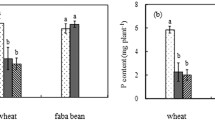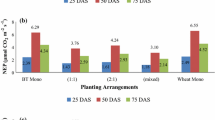Abstract
Wheat (Triticum aestivum L.) production by intercropping with faba bean (Vicia faba L.) has increased in popularity but is often associated with severe wheat powdery mildew (Blumeria graminis (DC.) Speer). Very little is known about the effects of below- and aboveground interspecific interactions on wheat nitrogen (N) nutrition and occurrence of wheat powdery mildew. A greenhouse pot experiment examined four N application rates and three belowground partition types (plastic film, nylon mesh partition or no partition) to study N nutrition and interactions between wheat and faba bean growing together. A field experiment investigated three N application rates and growth of wheat in monoculture and intercropped with faba bean with or without belowground plastic film partitions between wheat and faba bean. Disease incidence (DI) and disease severity index (DSI) were assessed at flowering stage and wheat leaves were sampled and analyzed for N. Foliar N was enhanced substantially by N addition in greenhouse and field conditions and also by belowground interactions (no partition compared with plastic film partition) in the pot experiment (all P < 0.001). There was a significant synergistic effect between N rate and belowground interactions on the enhancement of wheat N uptake (P < 0.01) in the pot experiment. DI and DSI of mildew increased markedly with increasing N rate in both experiments (all P < 0.001). In the pot experiment DI and DSI showed no marked differences among belowground partitions (both P > 0.05) but belowground interactions had different effects under different N rates, limiting disease occurrence under 0, 0.1 and 0.2 g N kg−1 soil but promoting disease with 0.05 g added N kg−1 soil. In the field experiment DI and DSI showed no significant differences between wheat monoculture and intercropping (both P > 0.05). However, the contributions of below- and aboveground interactions to disease control were different under different N rates, with interspecific root interactions increasing DI and DSI under different N rates and aboveground interactions increasing DI and DSI under zero-N application but decreasing DI and DSI at 150 and 300 kg N ha−1. The data suggest that the microclimate in the field and biological control mechanisms due to belowground interactions in wheat–faba bean associations may influence the incidence and severity of wheat powdery mildew.



Similar content being viewed by others
References
Bao SD (2000) Soil and agricultural chemistry analysis. China Agriculture Press, Beijing, China, pp 30–268
Bauhus J, Khanna PK, Menden N(2000) Aboveground and belowground interactions in mixed plantations of Eucalyptus globulus and Acacia mearnsii. Can J For Res 30:1886–1894
Bennett FGA (1984) Resistance to powdery mildew in wheat: a review of its use in agriculture and breeding programs. Plant Pathol 33:279–300
Browning JA, Frey KJ (1969) Multiline cultivars as a means of disease control. Annu Rev Phytopathol 7:355–382
Cahill Jr JF (1999) Fertilization effects on interactions between above- and belowground competition in an old field. Ecology 80:466–480
Cahill Jr JF (2002) Interactions between root and shoot competition vary among species. Oikos 99:101–112
Carroll JE, Wilcox WF (2003) Effects of humidity on the development of grapevine powdery mildew. Phytopathology 93:1137–1144
Cox CM, Garrett KA, Bowden RL, Fritz AK, Dendy SP, Heer WF (2004) Cultivar mixtures for the simultaneous management of multiple disease: Tan spot and leaf rust of wheat. Phytopathology 94:961–969
Dakora FD (2003) Defining new roles for plant and rhizobial molecules in sole and mixed plant cultures involving symbiotic legumes. New Phytol 158:39–49
Diekmann M, Falkengren-Grerup U (2002) Prediction of species response to atmospheric nitrogen deposition by means of ecological measures and life history traits. J Ecol 90:108–120
Gao ZM, Tan GJ, Xu CY, Ma FZ, Li ZY (1993) Quantitative effects of sowing time, density and nitrogenous fertilizer on wheat powdery mildew. J Anhui Agric Univ 20:18–24
Guttieri MJ, McLean R, Stark JC, Souza E (2005) Managing irrigation and nitrogen fertility of hard spring wheats for optimum bread and noodle quality. Crop Sci 45:2049–2059
Huber DM, Watson RD (1974) Nitrogen form and plant disease. Annu Rev Phytopathol 12:139–165
Jenkyn JF (1976) Nitrogen and leaf disease of spring barley. In: Fertilizer use and plant health. International Potash Institute, Worblaufen-Bern, Switzerland, pp 119–128
Jensen B, Munk L (1997) Nitrogen-induced changes in colony density and spore production of Erysiphe graminis f. sp. hordei on seedlings of six spring barley cultivars. Plant Pathol 46:191–202
Khanna PK (1997) Comparison of growth and nutrition of young monocultures and mixed stands of Eucalyptus globulus and Acacia mearnsii. Forest Ecol Manage 94:105–113
Kratochvil RJ, Harrison MR, Pearce JT, Conover KJ, Sultenfuss M (2005) Nitrogen management for mid-Atlantic hard red winter wheat production. Agron J 97:257–264
Li L, Sun JH, Zhang FS, Li XL, Yang SC, Rengel Z (2001) Wheat/maize or wheat/soybean strip intercropping. I. Yield advantage and interspecific interactions on nutrients. Field Crops Res 71:123–137
Li L, Zhang FS, Li XL, Christie P, Sun JH, Yang SC, Tang CX (2003) Interspecific facilitation of nutrient uptake by intercropped maize and faba bean. Nutr Cycling Agroecosyst 65:61–71
Liu XK (1989) Prospects of wheat powdery mildew research in China. Inf. Agric. Husb. August:1–10
Liu XK, Zhou YL (1988) Study on investigating method of wheat powdery mildew. Chinese J Plant Protect 2:17–20
Mitchell CE, Reich PB, Tilman D, Groth JV (2003) Effects of elevated CO2, nitrogen deposition, and decreased species diversity on foliar fungal plant disease. Glob Change Biol 9:438–451
Morgan JAW, Bending GD, White PJ (2005) Biological costs and benefits to plant–microbe interactions in the rhizosphere. J Exp Bot 56:1729–1739
Mundt CC (2002) Use of multiline cultivars and cultivar mixtures for disease management. Annu Rev Phytopathol 40:381–397
Nordin A, Nasholm T, Ericson L (1998) Effects of simulated N deposition on understorey vegetation of a boreal coniferous forest. Funct Ecol 12:691–699
Olesen JE, Mortensen JV, Jørgensen LN, Andersen MN (2000) Irrigation strategy, nitrogen application and fungicide control in winter wheat on a sandy soil. I.Yield, yield components and nitrogen uptake. J Agric Sci 134:1–11
Olesen JE, Jørgensen LN, Petersen J, Mortensen JV (2003) Effects of rate and timing of nitrogen fertilizer on disease control by fungicides in winter wheat. I. Grain yield and foliar disease control. J Agric Sci 140:1–13
Puppala V, Herrman TJ, Bockus WW, Loughin TM (1998). Quality response of twelve hard red winter wheat cultivars to foliar disease across four locations in central Kansas. Cereal Chem 75:94–99
Sander JF, Heitefuss R (1998) Susceptibility to Erysiphe graminis f. sp. tritici and phenolic acid content of wheat as influenced by different levels of nitrogen fertilization. J Phytopathol 146:495–507
Shen ZZ, Liang SS (2001) Annals of China Agriculture. China Agriculture Press, Beijing, China, pp 264–271
Strengbom J, Nordin A, Nasholm T, Ericson L (2002) Parasitic fungus mediates change in nitrogen-exposed boreal forest vegetation. J Ecol 90:61–67
Tao JF, Shen XZ, Qin JZ, Qin Y (1982) Studies on the resistance to powdery mildew in wheat species and varieties. Acta Phytopathol Sinica 12:7–14
Trenbath BR (1993) Intercropping for the management of pests and diseases. Field Crops Res 34:381–405
Varga B, Svečnjak Z, Maćešić D, Uher D (2005) Winter wheat cultivar responses to fungicide application are affected by nitrogen fertilization rate. J Agron Crop Sci 191:130–137
Wang ZL, Li LH, He ZH, Duan XY, Zhou YL, Chen XM, Lillemo M, Singh RP, Wang H, Xia XC (2005) Seedling and adult plant resistance to powdery mildew in Chinese bread wheat cultivars and lines. Plant Dis 89:457–463
Wu ZS (1990) Breeding for wheat disease resistance. In: Wu ZS (ed) Wheat breeding, China Agriculture Publishing Press, Beijing, pp 235–272
Xiao YB, Li L, Zhang FS (2004) Effect of root contact on interspecific competition and N transfer between wheat and fababean using direct and indirect 15N techniques. Plant Soil 262:45–54
Yu YX, Yang YH, Liu L (2000) Current situation and development strategy of wheat breeding in Yunnan Province. Southwest China J Agric Sci 13:91–97
Zhang MP, Zhang HY (1991) Impact of fertilizer on wheat diseases. Jiangsu Agric Sci 2:39–41
Zhu YY, Fang H, Wang YY, Fan JX, Yang SS, Mew TW, Mundt CC (2005) Panicle blast and canopy moisture in rice cultivar mixtures. Phytopathology 95:433–438
Zhu YY, Wang YY, Chen JB, Zhou HP, Li ZS, Li Y, Sun Y, Zhou KL, Wang M, Yang JC, Yang QH, Wang SM, Trevor H (2004) Crop diversity and disease control in wheat and faba bean. In: Zhu YY (ed) Biodiversity for sustainable crop disease management: theory and technology. Yunnan Science and Technology Press, Kunming, China, pp 461–470
Acknowledgements
We thank the Science and Technology Department of Yunnan Provincial Government (Project 2003FCCFC01A009), Program for Changjiang Scholars and Innovative Research Team in University (project IRT0511), the National Natural Science Foundation of China (Project 30460061) and the Natural Science Foundation of Yunnan Province (Projects 2003C0040M and 2003C0041M) for generous financial support.
Author information
Authors and Affiliations
Corresponding author
Rights and permissions
About this article
Cite this article
Chen, Y., Zhang, F., Tang, L. et al. Wheat powdery mildew and foliar N concentrations as influenced by N fertilization and belowground interactions with intercropped faba bean. Plant Soil 291, 1–13 (2007). https://doi.org/10.1007/s11104-006-9161-9
Received:
Accepted:
Published:
Issue Date:
DOI: https://doi.org/10.1007/s11104-006-9161-9




